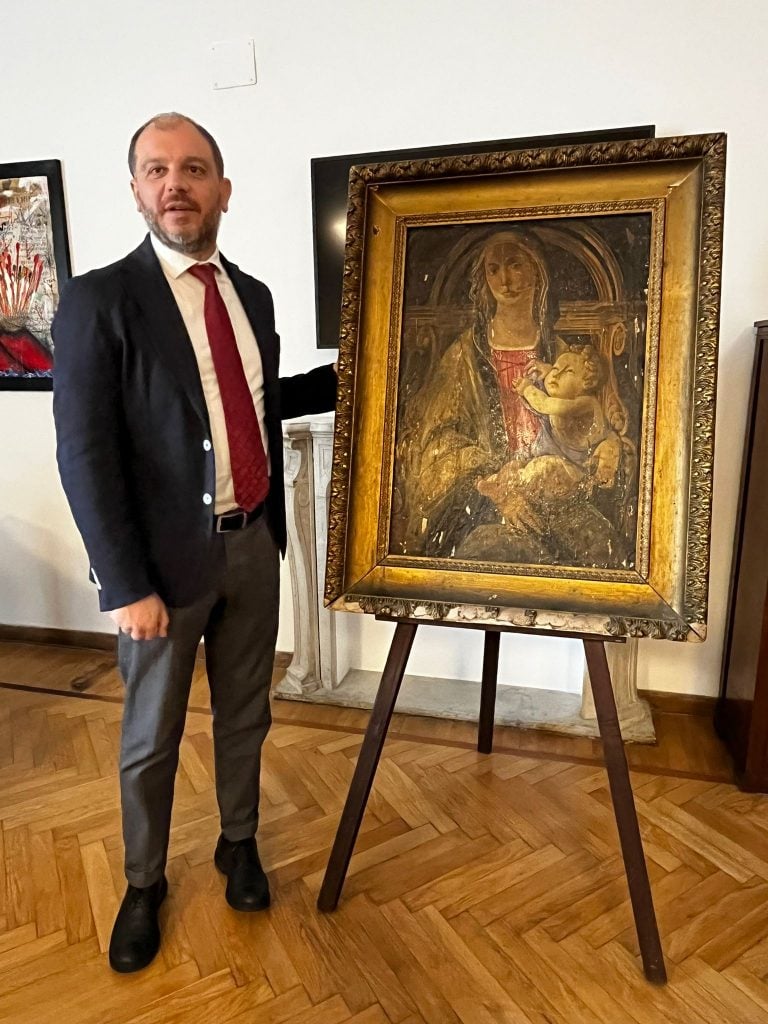Law & Politics
A Sandro Botticelli Painting, Forgotten for Decades, Was Seized by Italian Authorities From a Family’s Home
The painting is in very poor condition and must be preserved, a state agency said.

The painting is in very poor condition and must be preserved, a state agency said.

by
Adam Schrader

A family that was entrusted to care for a Sandro Botticelli painting for more than a century could lose possession of the work, worth around $109 million.
The government agency in Naples tasked with protecting cultural heritage has taken custody of a Madonna and Child (1481–82) by the Renaissance master, it announced in a news release.
The work was originally located in the chapel of Santa Maria delle Grazie in the town of S. Maria la Carità, but was moved at some point and entrusted to the Somma family, officials said.
Further identifying information about the family was not provided and officials did not state why the painting had originally been entrusted to them or precisely when it had entered the family home.
Italian government authorities had visited the Somma family to inspect the painting, most recently more than 50 years ago, and seemingly lost track of the work over time. It was not immediately clear how the work got back on the government’s radar.
The family handed the painting over to Superintendent Mariano Nuzzo, which the agency called the “final act of a process” led by Massimiliano Croce of the Carabinieri’s art protection unit in Naples. Nello D’Aurioa, the mayor of Gragnano, where the family lives, mediated the the painting’s handover.
The state cited Article 43 of the country’s Cultural Heritage Code for the reason behind the seizure, i.e. to guarantee the painting’s safety and ensure its preservation.
“The painting is in very poor conservation condition, showing in fact detachments of the paint film, color falls, abrasions and chromatic alterations due to both repainting and oxidation of overpainted protective varnishes,” the agency said in its statement.
An analysis using ultraviolet light showed extensive repainting and tampering, which officials said is what prompted an immediate withdrawal of the work into government custody.
But it remains unclear if the family, or the church, could eventually get the painting back. As reported by The Guardian, the Carabinieri are investigating whether the painting truly belongs to the family.
“If we were to verify that the family who owned it was not entitled to keep it then it will pass into the hands of the state,” Croce told The Guardian. “Otherwise, it could remain the property of the family but [be] exhibited in a museum to ensure greater security.”
Meanwhile, a new podcast documents the real-life twists and turns of a quest to recover a painting by the Baroque master Caravaggio, believed to have been stolen by the mafia from another Italian church in 1969.
More Trending Stories:
Art Critic Jerry Saltz Gets Into an Online Skirmish With A.I. Superstar Refik Anadol
The Old Masters of Comedy: See the Hidden Jokes in 5 Dutch Artworks
A Royal Portrait by Diego Velázquez Heads to Auction for the First Time in Half a Century
How Do You Make $191,000 From a $4 Painting? You Don’t
In Her L.A. Debut, South Korean Artist Guimi You Taps Into the Sublimity of Everyday Life
Two Rare Paintings by Sienese Master Pietro Lorenzetti Come to Light After a Century in Obscurity